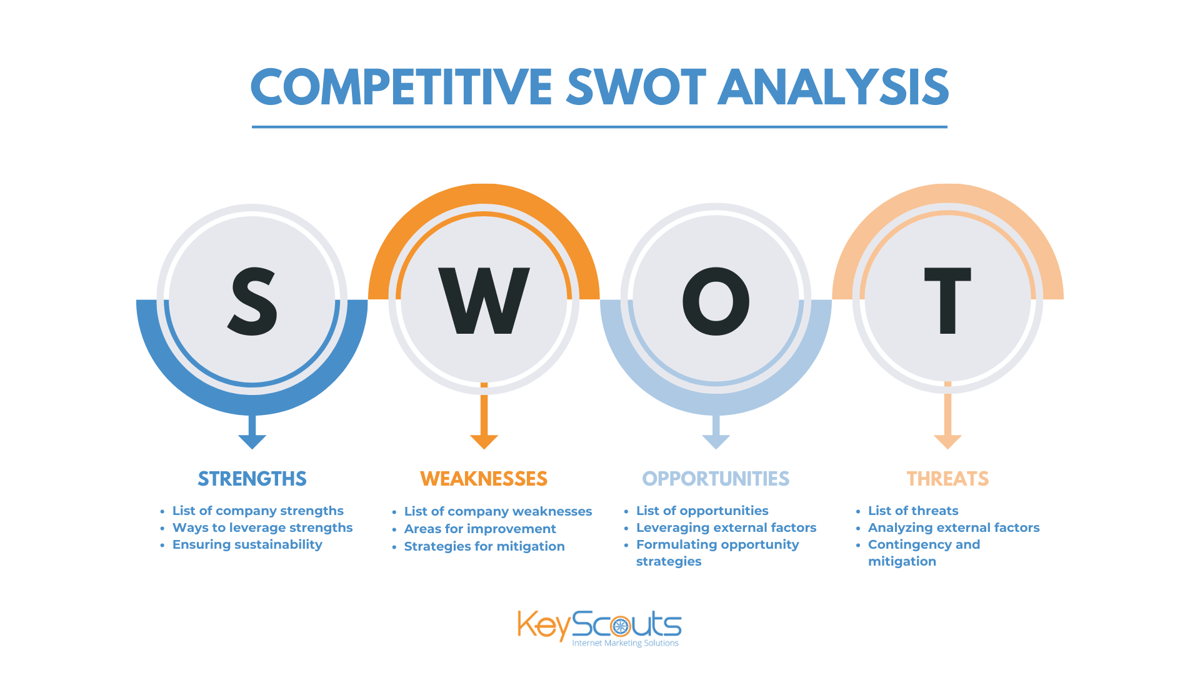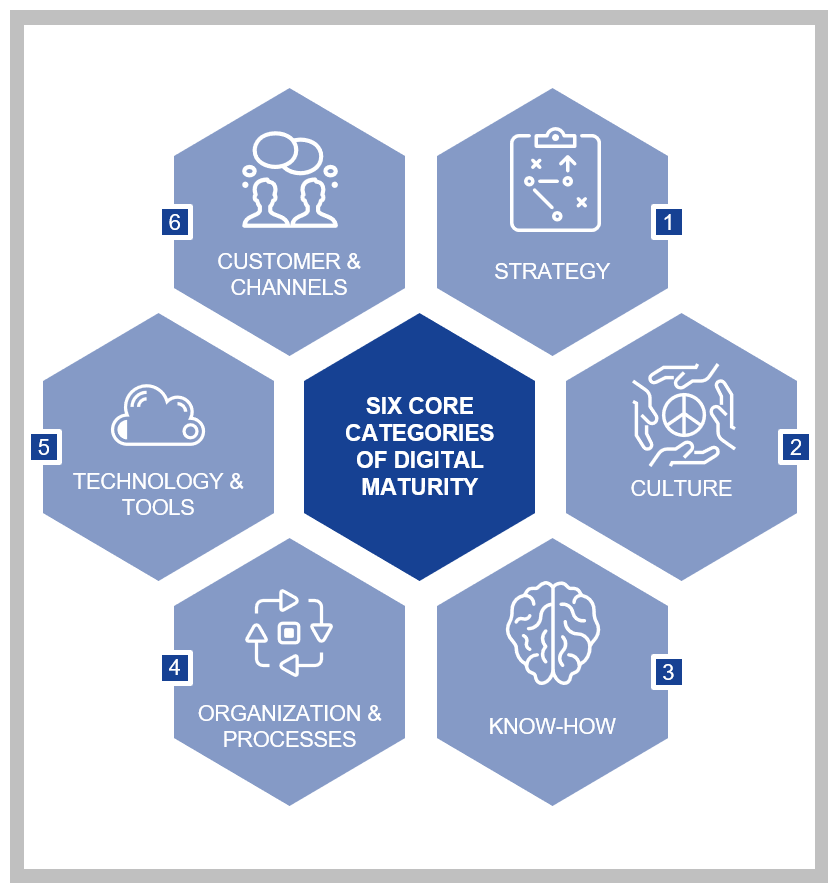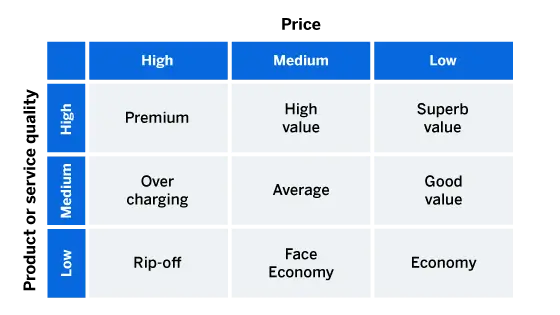
In the fast-paced world of B2B competition, knowing how to do B2B competitive analysis can be a game-changer. It can give your company the winning edge or leave it behind in the race.
Understanding B2B competitive analysis’s importance and getting familiar with the tools and techniques is a smart move to stay ahead. This is particularly important because 90% of B2B buyers are ready to switch to a competitor if their supplier's digital channels fall short of their expectations.
Why Does B2B Competitive Analysis Matters?
B2B competitive analysis (also B2B competitor analysis or B2B competitor research) is a strategic practice that involves assessing and evaluating your competitors in the market. This comprehensive approach involves scrutinizing competitors' tactics, strengths, weaknesses, and market positions.
The question arises: Why is it a fundamental component of a thriving B2B strategy?
Companies must adapt and respond effectively to the changing market conditions to stay relevant and competitive. Especially when new competitors emerge, market trends shift, and customer preferences evolve. This is where B2B competitive analysis comes into play.
Unlocking Market Opportunities
B2B competitive analysis is not just about keeping an eye on the competition; it's also about uncovering hidden opportunities. By analyzing your competitors' approaches, you can identify gaps in the market that they may have overlooked. This lets you strategically position your products or services to address these unmet needs.
Competitor analysis can lead you to untapped market opportunities, whether it's a new customer segment, a unique value proposition, or an innovative solution.
Informed Decision-Making with Data-Driven Insights
According to Gartner, by 2025, 60% of B2B sales organizations will shift from relying on intuition to embracing data-driven approaches.
You can collect and analyze data that informs your decisions by leveraging B2B competitive analysis techniques and tools, allowing your business to gain a competitive edge and make informed strategic choices.
Whether you're fine-tuning your marketing strategies, adjusting pricing models, or optimizing your product offerings, having access to comprehensive competitor data enhances the precision and effectiveness of your decisions.
Enhancing Your Competitive Edge
By understanding your competitors' strengths and weaknesses, you can leverage your strengths and address your weaknesses more effectively. This can lead to improved product development, targeted marketing campaigns, and a more substantial market presence.
Key Techniques for Effective B2B Competitive Analysis
Mastering competitive analysis techniques is pivotal for business success. They navigate rivalries, markets, and customer trends. Discover key B2B insights below for informed, strategic choices.
1. SWOT Analysis
SWOT Analysis is a cornerstone of B2B competitive analysis, and its value cannot be overstated. This strategic tool empowers organizations to evaluate their position in the market holistically, offering a comprehensive view of their internal capabilities and external landscape.

Through systematically assessing Strengths, Weaknesses, Opportunities, and Threats, SWOT Analysis equips decision-makers with actionable insights that inform business strategies and drive success. Here's a more detailed breakdown of this essential tool:
Strengths (S):
- Recognize your internal assets: talented personnel, cutting-edge technology, or a robust brand reputation.
- Use strengths to enhance competitiveness and seize opportunities.
- Ensure sustainable strengths for effective strategy.
Weaknesses (W):
- Identify internal weaknesses: operational inefficiencies, skill gaps, or outdated infrastructure.
- Spot areas needing enhancement or investment to avoid issues.
- Create plans to address and improve weaknesses for better competitiveness.
Opportunities (O):
- Investigate trends, market gaps, and growth possibilities.
- Spot external factors to expand presence or diversify.
- Create strategies to capture opportunities in line with strengths.
Threats (T):
- Assess external risks: regulations, economy, competition.
- Create plans to protect against potential threats.
- Ensure strengths and opportunities can counter threats.
2. Strategy Evaluation: Marketing Strategies, Segments Served, and Market Share
Now, it’s time to identify where you stand in the market and where opportunities lie.
Marketing Strategies:
- Segmented Approach: Analyze competitor marketing tactics and channels for effective segmentation.
- Content and Messaging: Evaluate their content by reviewing content quality, tone, and engagement.
- Brand Perception: Explore competitors' brand positioning and alignment with market needs.
Segments Served:
- Customer Profiles: Know your competitors' customer profiles: ideal clients, industries, demographics, and geographies.
- Value Proposition: Assess how competitors meet customer needs and their value proposition.
- Market Coverage: Investigate competitors' market penetration and untapped opportunities.
Market Share:
- Market Analysis: Understand competitors' market share and strategies for success.
- Growth Trends: Monitor competitors' growth trends and challenges. Are they expanding, consolidating, or facing challenges?
- Market Position: Assess your market position and strategies for enhancement.
3. Website Comparison: UX, Social Integration, and Content Quality
A deep dive into competitors' websites can reveal a wealth of information. Assessing user experience (UX), social media integration, and the quality of their content can inform your web strategy.

User Experience (UX):
- Navigation and Layout: Investigate the user-friendliness of your competitors' websites. Are they well-structured, with clear navigation paths and intuitive layouts?
- Speed and Responsiveness: Assess their sites' loading speed and responsiveness. How well do they perform on various devices and internet connections?
- Aesthetics: Scrutinize the visual design of their websites. Do they employ appealing aesthetics, colors, and graphics that resonate with their target audience?
Social Media Integration:
- Platform Presence: Explore how your competitors integrate various social media platforms into their websites. Do they effectively leverage channels like Facebook, Twitter, LinkedIn, or Instagram?
- Content Sharing: Analyze how they encourage users to share their content on social media. Are there easily accessible sharing buttons and options?
- Engagement: Look at the level of engagement on their social media profiles. Do they foster meaningful interactions with their audience through comments, likes, and shares?
Content Quality:
- Relevance: Evaluate the quality and relevance of the content on competitors' websites. Is the information up-to-date and tailored to the needs of their audience?
- Depth and Variety: Examine the depth and variety of content formats, from blog posts and articles to videos and infographics. Are they catering to diverse preferences?
- Authority and Credibility: Assess their industry authority by checking for citations, references, and the use of authoritative sources.

4. Social Media Monitoring
By monitoring your competitors' social media activity, you can gain insights into their audience engagement, content strategy, and brand perception.
Audience Engagement:
- Follower Growth: Track the growth of your competitors' social media followers. Are they consistently attracting a larger audience?
- Engagement Metrics: Analyze engagement metrics such as likes, shares, comments, and retweets to gauge the impact of their content.
- Response Time: Observe how promptly your competitors respond to inquiries and comments on their social media posts.
Content Strategy:
- Content-Type: Identify the types of content your competitors are sharing, such as blog posts, videos, infographics, or webinars.
- Frequency: Assess how frequently they post on social media. Are they maintaining a regular content schedule?
- Themes and Messaging: Scrutinize the themes and messaging in their content. Are they consistent with their brand identity and target audience?
Brand Perception:
- Sentiment Analysis: Conduct sentiment analysis on comments and discussions related to your competitors. Are they receiving positive, negative, or neutral feedback?
- Crisis Management: Study how they handle negative publicity or crises on social media. Do they respond proactively and effectively?
Influence and Partnership:
- Influencer Collaborations: Identify any partnerships or collaborations with influencers and industry leaders.
- Content Sharing: Observe how often others share their content in your industry. Are they gaining traction in their niche?
Paid Advertising:
- Ad Campaigns: Keep an eye on your competitors' paid advertising campaigns on social media. What messages are they promoting, and how are they targeting their ads?
- Ad Spend: Estimate the budget they allocate to social media advertising and identify trends in their spending.
5. Backlink Tracking and SEO Monitoring
Backlinks are critical to SEO. Monitoring your competitors' backlinks and SEO efforts can help refine your SEO strategy.
Competitor Backlink Analysis:
- Backlink Sources: Identify the sources from which your competitors acquire backlinks. Are they predominantly from reputable and authoritative websites?
- Link Diversity: Analyze the diversity of the types of websites linking to your competitors. Are they from various domains, including blogs, news outlets, forums, and industry directories?
- Anchor Texts: Examine the anchor texts used in these backlinks. Are they diverse and relevant to the content being linked to?
SEO Strategy Evaluation:
- Keyword Strategy: Investigate the keywords your competitors target in their content. Are they optimizing for the exact keywords of your business?
- On-Page SEO: Assess how effectively they have optimized their on-page elements, including title tags, meta descriptions, header tags, and image alt tags.
- Content Quality: Evaluate the quality and relevance of their content with targeted keywords. Are they consistently producing valuable and informative content?
- Mobile Optimization: Analyze how mobile-friendly their websites are, as mobile-friendliness is a crucial SEO factor.
Performance Metrics:
- Ranking Positions: Monitor your competitors' search engine rankings for key keywords. Are they consistently outranking your website?
- Organic Traffic: Observe the organic traffic trends of your competitors. Are they experiencing consistent growth in organic visits?
- Conversion Rates: Analyze their website's conversion rates. How effectively are they turning visitors into leads or customers?
Local SEO Insights:
- Local Citations: For businesses with physical locations, track the number and consistency of local citations and directories in which your competitors are listed.
- Google My Business: Examine how they manage their Google My Business profiles and customer reviews.
6. Digital Health Check

Evaluating the overall digital health of your competitors can reveal vulnerabilities and areas where you can gain a competitive edge. Let's break down the critical elements and methods that make the Digital Health Checkup an essential practice for your competitive analysis:
Website Assessment:
- User Experience (UX): Evaluate your competitors' websites' user-friendliness, layout, and responsiveness. How easy can users navigate and interact with their web content?
- Mobile Optimization: Examine their websites' mobile optimization to ensure they cater to the ever-growing mobile audience.
- Speed and Performance: Assess their websites' loading speed and overall performance. How well do they perform under different conditions and devices?
- Content Quality: Investigate the quality, relevance, and engagement level of the content they publish. Is it valuable and up-to-date?
- SEO Health: Analyze the search engine optimization (SEO) factors affecting their websites, including keywords, meta tags, and backlinks.
Social Media Presence:
- Platforms and Engagement: Identify the social media platforms where your competitors maintain a presence. How effectively do they engage with their audience on these channels?
- Content Strategy: Scrutinize the types of content they share, frequency of posts, and themes. Are they creating compelling content that resonates with their target audience?
- Follower Growth: Track the growth of their social media followers and assess the consistency of their audience-building efforts.
Digital Marketing Strategies:
- Paid Advertising: Analyze their paid advertising campaigns, including channels used, ad types, and targeting strategies.
- Email Marketing: Examine the effectiveness of their email marketing campaigns, including open rates, click-through rates, and conversion rates.
- Conversion Optimization: Assess how well their websites convert visitors into leads or customers. Are they employing effective conversion optimization techniques?
Digital Marketing Strategies:
- Paid Advertising: Analyze their paid advertising campaigns, including channels used, ad types, and targeting strategies.
- Email Marketing: Examine the effectiveness of their email marketing campaigns, including open rates, click-through rates, and conversion rates.
- Conversion Optimization: Assess how well their websites convert visitors into leads or customers. Are they employing effective conversion optimization techniques?
7. Pricing Analysis
By analyzing competitor pricing, you can refine your strategy. Digging into rivals' pricing uncovers insights for competitive positioning and effective pricing. Explore competitor price points, discounts, models, and dynamic strategies.
Competitor Pricing Strategies:
- Price Points: Assess your competitors' pricing. Are they pricing competitively, or are they positioning themselves as premium providers?
- Discounts and Promotions: Analyze the discounts, promotions, and special offers your competitors employ. Are they driving customer acquisition and retention through these tactics?
- Pricing Models: Investigate competitor’s pricing models. Do they offer subscription-based pricing, tiered pricing, or usage-based pricing?
- Dynamic Pricing: Check if your competitors employ dynamic pricing strategies that adjust prices based on demand, time, or customer behavior.

Value Proposition and Positioning:
- Value-Added Services: Assess the value-added services or features your competitors include with their pricing. Are there additional services that differentiate their offerings?
- Brand Perception: Analyze how their pricing aligns with their brand perception. Are they emphasizing quality, affordability, or innovation?
- Target Market Segmentation: Examine whether competitors use different pricing strategies for customer segments. Are they targeting specific industries or customer types?
Profitability and Margins:
- Cost Structure: Investigate your competitors' cost structures, including production, overhead, and marketing expenses.
- Profit Margins: Determine the profit margins they are aiming for. Are they operating with low margins to gain market share, or do they prioritize higher margins?
Customer Feedback and Reviews:
- Customer Perception: Analyze customer reviews and feedback to understand how customers perceive their pricing. Are customers satisfied with the value they receive?
- Pricing Complaints: Look for common pricing-related complaints or customer issues. Are there areas where your competitors are falling short?
Tools for B2B Competitive Analysis
To execute effective B2B competitive analysis, you need the right tools. Some of the top tools include Monitor Backlinks, Moz, Website Grader, SEMrush, Google Analytics, and Lighthouse. These tools provide a data-driven foundation for your analysis.
|
Tool |
Description |
How It Helps |
|
Monitors your competitors' backlink profiles. |
Helps identify their link-building strategies and gauge the strength of their online presence. |
|
|
Offers a suite of SEO tools, including keyword research, site auditing, and link analysis. |
Assists in assessing the SEO performance of competitors' websites and uncovering keyword strategies. |
|
|
Analyzes websites based on performance, mobile-friendliness, and SEO. |
Provides insights into your competitors' website strengths and weaknesses. |
|
|
Offers a comprehensive suite of competitive analysis tools, including domain analytics, keyword research, and backlink analysis. |
Enables you to dive deep into competitor data, uncovering their SEO tactics and keyword strategies. |
|
|
Provides valuable insights into website traffic and user behavior, including competitor websites. |
Allows you to compare website traffic and user engagement metrics with your competitors. |
|
|
Assesses website performance and offers recommendations for improvements. |
Helps identify areas where competitors' websites may be lacking in performance. |
Implementing Findings from Competitive Analysis
There's no one B2B competitor analysis template. A real game-changer lies in how you implement the findings from your analysis. This involves capitalizing on competitive advantages, addressing market opportunities, mitigating risks, and revamping your marketing strategies to ensure you're always one step ahead.
B2B Competitive Analysis: Capitalizing on Competitive Advantages
One of the primary goals of competitive analysis in B2B is to identify and capitalize on your competitive advantages. This could involve leveraging your strengths, differentiating your products or services, or refining your value proposition.
Addressing Market Opportunities
Competitor analysis can unveil untapped market opportunities. You can strategically expand your business by identifying gaps in your competitors' offerings or underserved customer segments.
Mitigating Risks
Understanding the threats competitors pose allows you to mitigate risks proactively. Risk mitigation is crucial to competitive analysis, whether addressing vulnerabilities in your strategy or preparing for potential challenges.
Revamping Marketing Strategies
With a comprehensive understanding of your competitive landscape, you can refine and optimize your marketing strategies. This includes tailoring messaging, targeting the right audience, and choosing the most effective channels.
Wrapping Up
The call for B2B competitive analysis is ongoing. In the ever-shifting realm of business, keeping tabs on your competitors and market trends is crucial for long-lasting success. Being open to change and adjusting isn't just a tactic; it's a must for growing. As we navigate the twists and turns of modern B2B business, always remember that competitive analysis is your guiding star, leading you toward steady growth and enduring triumph.





